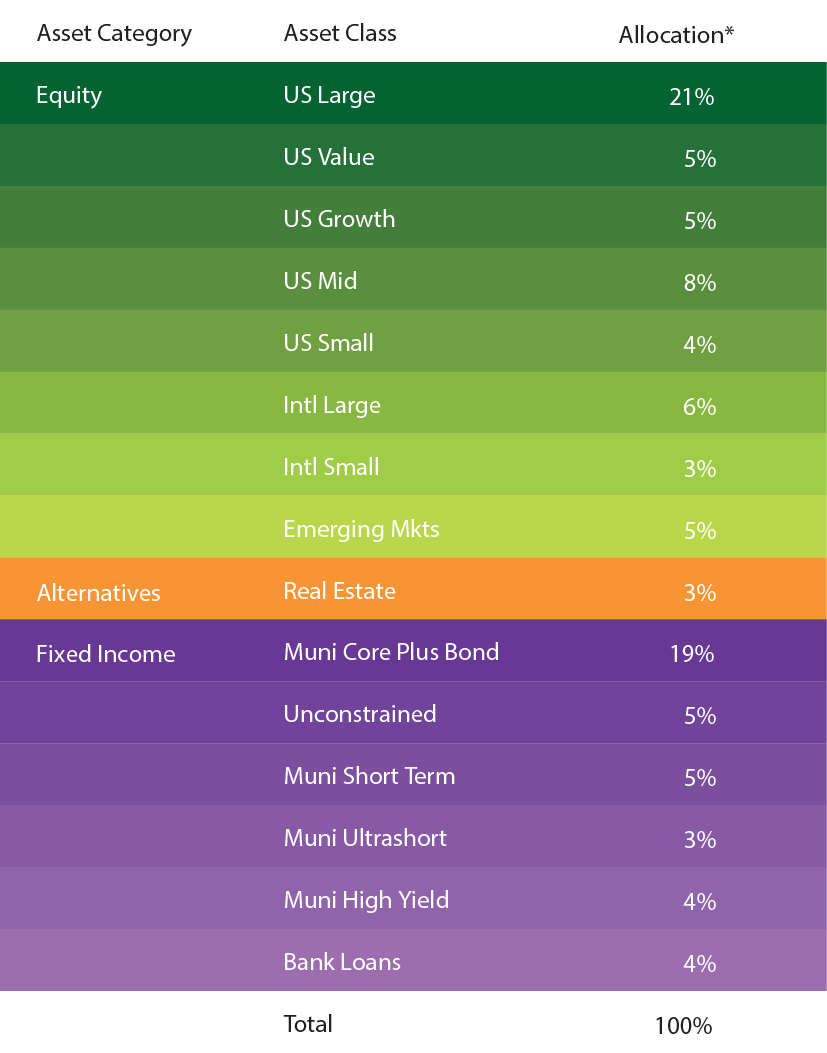We put risk management first in strategically designing global, well diversified, balanced portfolios that are focused on the long-term.
All strategies range from 100% to 30% equity in 10% increments.
Investment Objective
The primary objective of Dynamic Tax Aware is to focus on reducing the tax burden for tax sensitive clients, with a secondary objective to maximize long-term risk-adjusted returns while allocating to a broadly diversified variety of asset classes utilizing ETFs.
Investment Approach
Utilize non-proprietary ETFs to invest in tax-advantaged investments such as municipal bonds with higher conviction portfolio tilts and more granular asset class exposures.
Asset Class Breakdown 60/40

*For illustrative purposes only. Allocations are subject to change.
Why ETFs?
- Lower cost: ETFs typically offer a significant cost savings relative to mutual funds.
- Tax efficiency: ETFs typically distribute fewer capital gains than mutual funds.
- Transparency: ETFs typically report their holdings daily and track an index, providing stability in exposure and risk.
Why Be Tax Aware?
- After-Tax Returns: While investors generally focus on pre-tax returns on portfolio statements, they certainly feel the pain when filing their annual tax returns. Investing in securities which may be exempt from certain taxes increases the overall benefit to investors in the form of enhanced after-tax returns.
- Rising Taxes: As your wealth increases, so do your tax rates. Since bond interest is taxed as ordinary income, it may be prudent to diversify your fixed income exposures into more tax efficient investments.
- Gain Preservation: By paying less in taxes, investors get to keep more of their gains. These extra proceeds can be reinvested and help to compound and strengthen future portfolio growth.
Why Municipal Bonds?
- Tax Reduction: Interest from municipal bonds is generally exempt from federal taxation, allowing investors to keep more of the income they generate. For example, a municipal bond yielding 4% for an investor with a 30% income tax rate has a tax-equivalent yield of 5.7%.
- Enhanced Diversification: There is a wide variety of municipal bonds in the marketplace. They are differentiated by issuing state, municipality, credit quality, and purpose (revenue bonds, school bonds, etc.). A portfolio of municipal bonds can achieve a high level of diversification, not unlike a portfolio of traditional bonds.
- Lower Risk: Given that municipal bonds are typically issued by government entities, they generally have a higher credit quality and an increased probability of returning principal.
There is no guarantee that the model portfolios or any investment strategies will work under all or any market conditions. They may not be appropriate for all investors and each investor should evaluate their ability to invest long-term, especially during periods of a downturn in the market. Past performance is not a guarantee of future returns.
